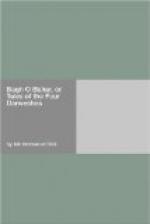[35] Shahjahan was the most magnificent king of Dilli, of the race of Taimur, Sahib Kiran was one of his titles, and means, Prince of the Happy Conjunction; i.e. the conjunction of two or more auspicious planets in one of the signs of the Zodiac at the hour of birth. Such was the case at the birth of Taimur, who was the first we read of as Sahib-Kiran. As a contradistinction, Shahjahan is generally called Sahib Kirani Sani, or the second Sahib Kiran. It never waw applied, as Ferdinand Smith states, to all the emperors of Dilli. It may be mentioned, that a very extraordinary conjunction of the planets in the sign Libra took place in A.D. 1185, just about the period of Jangis Khan’s appearance as a conqueror; but I am not aware that he was thence called a Sahib Kiran, as he did not happen to be born under the said conjunction.
[36] The fort, or rather fortified place, of Dilli, and the great mosque, called the Juma’ Masjid.
[37] The famous Takhti Ta,us, or peacock throne, made by the magnificent Shahjahan, the richest throne in the world; it was valued at seven millions sterling. Tavernier, the French jeweller and traveller, saw it and describes it in his work. It was carried away by Nadir Shah when he plundered Dilli in 1739.
[38] The expensive and useless canal which brought fresh water to Dilli, whilst the limpid and salutary stream of the Jumna flowed under its walls. The advantages of irrigation to the country, through which it passed, were nothing compared to the expense of its construction.
[39] Literally, “the supreme camp or market.”
[40] A Persian expression.
[41] Shah ’Alam the emperor of Dilli, was then towards Patna a tool in the hands of Shuja’u-d-Daula, the Nawwab of Lakhnau, and Kasim ’Ala Khan, the Nawwab of Murshid-abad.
[42] Alluding to the confusion which reigned in Upper Hindustan after the assassination of ’Alamgir the Second, and the flight of Shah ’Alam. Upper Hindustan was then in a sad plight, ravaged alternately by the Abdalis, the Marhattas, and the Jats—the king a pageant, the nobles rebellious, the subjects plundered and oppressed, and the country open to every invader—though this was near 100 years ago, and although they had some government, justice, and security from 1782 to 1802, yet the country had not even then recovered from the severe shock.
[43] The word is used in the singular, both by Mir Amman and the original author, Amir Khusru according to a well-known rule in Persian syntax, viz., “a substantive accompanied by a numerical adjective dispenses with the plural termination,” as “haft roz,” “seven days,” not “haft rozha. The Persian term darwesh, in a general sense, denotes a person who has adopted what by extreme courtesy is called a religious life, closely akin to the “mendicant friar” of the middle ages; i.e., a lazy, dirty, hypocrital vagabond, living upon the credulous public. The corresponding term in Arabic is Fakir; and in Hindi, Jogi.




